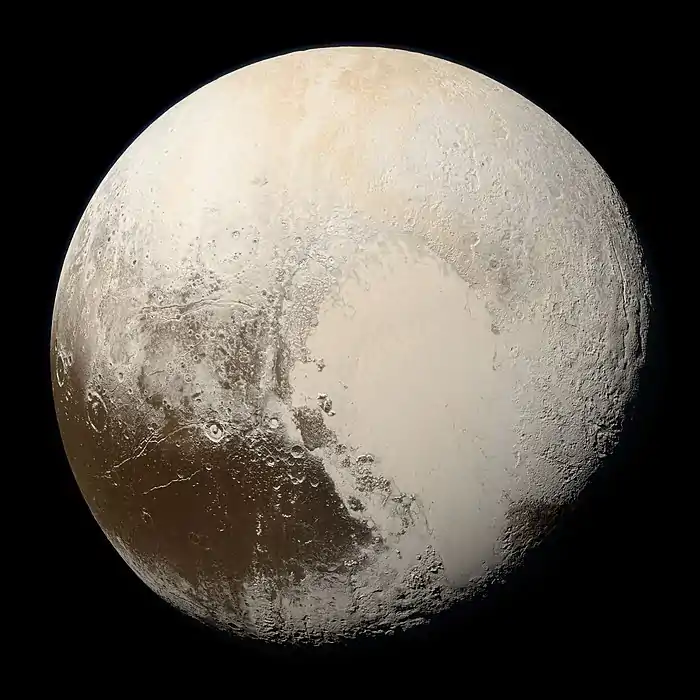| Discovery[1][2] | |
|---|---|
| Discovered by | Palomar Obs. |
| Discovery site | Palomar Obs. |
| Discovery date | 10 December 2002 |
| Designations | |
| (78799) 2002 XW93 | |
| 2002 XW93 | |
| TNO[2] · centaur[3] other TNO[4] · distant[1] | |
| Orbital characteristics[2] | |
| Epoch 27 April 2019 (JD 2458600.5) | |
| Uncertainty parameter 4 | |
| Observation arc | 18.76 yr (6,852 d) |
| Earliest precovery date | 17 December 1989 |
| Aphelion | 46.812 AU |
| Perihelion | 27.909 AU |
| 37.360 AU | |
| Eccentricity | 0.2530 |
| 228.36 yr (83,410 d) | |
| 145.37° | |
| 0° 0m 15.48s / day | |
| Inclination | 14.383° |
| 46.928° | |
| 247.18° | |
| Physical characteristics | |
Mean diameter | 565+71 −73 km[3][4] 584 km[5] |
| 0.038[3][4] | |
| 5.5[1][2] | |
(78799) 2002 XW93, provisional designation 2002 XW93, is a trans-Neptunian object and centaur from the outer Solar System, approximately 500–600 kilometers (300–400 mi) in diameter. It was discovered on 10 December 2002, by astronomers at the Palomar Observatory in California.[1]
Orbit and physical characteristics
2002 XW93 orbits the Sun at a distance of 27.9–46.8 AU once every 228 years and 4 months (83,410 days; semi-major axis of 37.36 AU). Its orbit has an eccentricity of 0.25 and an inclination of 14° with respect to the ecliptic.[2] The body's observation arc begins with a precovery published by the Digitized Sky Survey and taken Palomar in December 1989, or 13 years prior to its official discovery observation.[1]
As of 2016, after a total of 29 observations, its orbital uncertainty parameter is at 3. Its last observation was made by the Hubble Space Telescope in September 2008.[1] On 10 August 1926, it most recently reached perihelion, when it was nearest to the Sun.[6][1] It is a near 5:7 resonant trans-Neptunian object.
Numbering and naming
This minor planet was numbered by the Minor Planet Center on 15 April 2004.[7] As of 2023, it has not been named.[1]
References
- 1 2 3 4 5 6 7 8 "78799 (2002 XW93)". Minor Planet Center. Retrieved 17 November 2018.
- 1 2 3 4 5 "JPL Small-Body Database Browser: 78799 (2002 XW93)" (2008-09-20 last obs.). Jet Propulsion Laboratory. Retrieved 17 November 2018.
- 1 2 3 "Asteroid (78799) 2002 XW93". Small Bodies Data Ferret. Retrieved 17 November 2018.
- 1 2 3 Johnston, Wm. Robert (7 October 2018). "List of Known Trans-Neptunian Objects". Johnston's Archive. Retrieved 14 November 2018.
- ↑ "How many dwarf planets are there in the outer solar system?". Retrieved 2 January 2015.
- ↑ Marsden, Brian G. (24 December 2003). "MPEC 2003-Y55 : 2002 XW93". IAU Minor Planet Center. Harvard-Smithsonian Center for Astrophysics. Retrieved 2 January 2015.
- ↑ "MPC/MPO/MPS Archive". Minor Planet Center. Retrieved 24 February 2018.
External links
- Asteroid Lightcurve Database (LCDB), query form (info Archived 16 December 2017 at the Wayback Machine)
- Discovery Circumstances: Numbered Minor Planets (75001)-(80000) – Minor Planet Center
- (78799) 2002 XW93 at AstDyS-2, Asteroids—Dynamic Site
- (78799) 2002 XW93 at the JPL Small-Body Database
_(cropped).jpg.webp)
